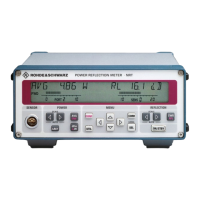Remote Control - Commands
NRP2
238User Manual 1173.9140.02 ─ 07
The parameters LFR (lower frequency range) and UFR (upper frequency range) limit
zeroing to a lower and an upper frequency range, thus reducing the required time by
half. These parameters are not accepted by all sensors. Before using them, you should
consult the manual of the sensor concerned.
Another possibility to perform zeroing faster is to use the command
CALibration<[1]..4>:
ZERO:FAST:AUTO in the trace mode.
The commands are overlapping, i.e. other commands can be sent to the R&S NRP2
while one or more calibrations are running.
Zeroing is recommended if
●
the temperature has varied by more than about 5 °C,
●
the sensor has been replaced,
●
no zeroing was performed in the last 24 hours,
●
signals of very low power are to be measured, for instance, if the expected mea-
sured value is less than 10 dB above the lower measurement range limit.
Parameters:
<state> ON | OFF | ONCE | LFR | UFR
*RST: OFF
CALibration<[1]..4>:ZERO:FAST:AUTO <state>
CALibration:ALL:ZERO:
FAST:AUTO
<state>
Perform fast zeroing. However, the commands cannot be called unless the sensor(s)
is(are) in the Trace mode. Since the commands are processed very quickly, they are
not overlapping. The queries therefore always return OFF.
Error messages:
-224 "Illegal parameter value": The transfer parameter is a numeric value unequal 0 (corre-
sponds to OFF).
Parameters:
<state> OFF | ONCE
*RST: OFF
6.7 DISPlay
The DISPlay command system is mainly used to configure the display of windows on
the R&S
NRP2. The WINDow commands are assigned to the calculate blocks 1 to 4.
The values calculated from the sensor values by the respective calculate block with the
aid of the measurement function are displayed.
Suffix [1]..4 denotes the number of the calculate block.
DISPlay
北京海洋兴业科技股份有限公司(证券代码:839145)

